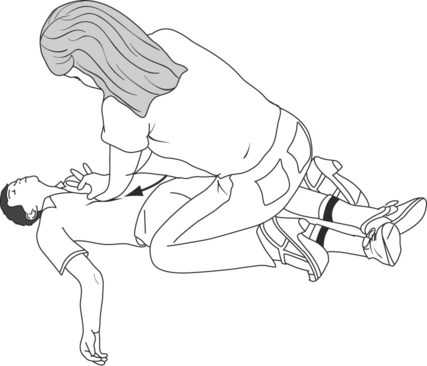This section may be photocopied and distributed to families. 1. Ask the child if he is choking. Check if he can talk or make noise. If the child cannot make any sounds, cannot cry (younger child), has bluish lips or skin, makes the choking sign of clutching neck with both hands, or has high-pitched noisy breathing, then begin emergency treatment. 2. Stand or kneel behind the child (Figure 1). 3. Wrap your arms around the child’s waist. Make one hand into a fist. 4. Put your fist, with the thumb side against the child’s skin, on the abdomen just above the belly button. Make sure you are well below the breastbone. 5. Grab the fist with your other hand. Press into the child’s abdomen with upward thrusts until the object comes out or until the child loses consciousness. 6. Each thrust should be a separate movement. This allows enough force to help the child expel the object. 7. If the child still cannot breathe, continue the thrusting while calling for help. 8. Continue your actions until the object is removed, help arrives, or the child becomes unconscious. If the child becomes unconscious, call the emergency telephone number (911) at once. 1. If the child is on the floor, ask if the child is OK. If she cannot breathe or talk, place the child flat on her back. 2. Kneel on the floor at the child’s feet. For a larger child you can straddle the legs. 3. Put the heel of one hand on the child’s abdomen just above the belly button. Make sure you are well below the breastbone. 4. Put your other hand on top of the first hand and press into the child’s abdomen with a quick upward thrust (Figure 2).
Wilson & Hockenberry: Wong’s Clinical Manual of Pediatric Nursing, 8th Edition
Patient Teaching Guide
Caring for the Choking Child*†
Awake and Alert (Conscious) Child—Sitting or Standing
Awake and Alert (Conscious) Child—Lying Down
![]()
Stay updated, free articles. Join our Telegram channel

Full access? Get Clinical Tree


Wilson & Hockenberry: Wong’s Clinical Manual of Pediatric Nursing, 8th Edition: Patient Teaching Guide
Get Clinical Tree app for offline access


